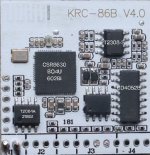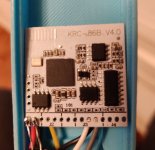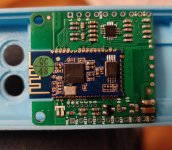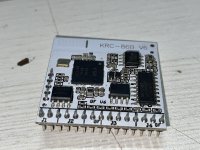I read @aditya's question about the Bluetooth speaker and was responding to just that portion. It's a good question on an active circuit to specifically break ground loops within integrated products. I'm not sure.Yes I know how a battery or wall wart breaks the ground loop. In fact this is how my bluetooth is set up; it runs off a 12 volt wall wart.
I was speaking in general terms but specifically, how would I break the ground loop when I use a bluetooth receiver board integrated into an existing preamplifier? I've read where people use transformers to break the loop (obvious but undesirable). A separate winding on the power transformer is another easy solution if you have that option.
Or maybe I'm overthinking it? The boards I build always have a separate power and "noise" ground. I run all the noise grounds to a reference point (typically the volume control) and then one wire to the power supply ground. This works great with no ground loop or noise problems. Maybe it's that simple?
I see what you're saying. I don't think I've come across anything specifically for this use case but I've come across some things that are more relevant to mixed signal/RF, I'll try to link any I find.red
A 12v / 1 Amp wall wart powers the JBL speaker.
These were Desktop speakers so no battery.
Second, I am trying to say that we need to understand RF design for PCB layout and not just what Tom( he is not wrong ) suggests for the amp to be applied in the case of the Bluetooth board. _ I am still learning
We need to have a very low impedance path to ground path for one for sure. - Ground pours
We need to understand how the current flows on that board and how it would impact the other sections.
Wires do not work in this case, they may have worked for amplifiers but not here.
@Fast Eddie D & @dkfan9
I have tried a bit, with FFC approved module and a simple Chinese module, But the best result has been a Raspberry Pi running Moode Audio OS with a Dac and a stand-alone Amplifier.
in the end, after seeing my JBL Jembe Board - I concluded that there is indeed some Black Magic just like the High-speed PCB design ref Book with the same name.
I am not saying to dishearten someone but looking and studying to find the solution used by manufacturers and also designing a 4-layer board is not a simple task. One thing I do know is that the ground points should be single from each point ending up in a big ground plan, having wires to connect
I have tried a bit, with FFC approved module and a simple Chinese module, But the best result has been a Raspberry Pi running Moode Audio OS with a Dac and a stand-alone Amplifier.
in the end, after seeing my JBL Jembe Board - I concluded that there is indeed some Black Magic just like the High-speed PCB design ref Book with the same name.
I am not saying to dishearten someone but looking and studying to find the solution used by manufacturers and also designing a 4-layer board is not a simple task. One thing I do know is that the ground points should be single from each point ending up in a big ground plan, having wires to connect
one thing I know is we need via stitching at 1.5mm and max 3.0mm distance which I understood from the RN52 evaluation board or the W32 Silicon Audio's Bluetooth manual.
I also have a wall wart fed JBL Dock with Clock on which I use a simple Bluetooth receiver that has a 30pin iPod connector - It plays like a charm
JBL Dock "on Time" has a 4layer board and it's mentioned on the silk screen.
I also have a wall wart fed JBL Dock with Clock on which I use a simple Bluetooth receiver that has a 30pin iPod connector - It plays like a charm
JBL Dock "on Time" has a 4layer board and it's mentioned on the silk screen.
I confirm the ground loop problem being related to pulsating current draw of BT-modules. For my knowledge the BT-chips internally often provide symmetrical audio outputs - that simply are not routed to drive an asymm stereo 3.5mm jack. Could be a good idea to use full symm audio outputs (instead of the audio transformer) to suppress common gnd noise.one thing I know is we need via stitching at 1.5mm and max 3.0mm distance which I understood from the RN52 evaluation board or the W32 Silicon Audio's Bluetooth manual.
I also have a wall wart fed JBL Dock with Clock on which I use a simple Bluetooth receiver that has a 30pin iPod connector - It plays like a charm
JBL Dock "on Time" has a 4layer board and it's mentioned on the silk screen.
you could look at DRV603 /1/2 from TI it has some intern circuits to break ground loops They are Balanced input Line driver chips with 2vpp output.I confirm the ground loop problem being related to pulsating current draw of BT-modules. For my knowledge the BT-chips internally often provide symmetrical audio outputs - that simply are not routed to drive an asymm stereo 3.5mm jack. Could be a good idea to use full symm audio outputs (instead of the audio transformer) to suppress common gnd noise.
Some Bluetooth chips have configurable outputs what I mean is Single Ended or Psuedo differential ie 3 wire where the common wire place the role of "-" in the case of normal Differential.
There are Bluetooth modules like RN52 which can do I2S out so directly digital out and Also Normal Differential = L+/-, and R+/-
well, I have bought this module, KRC-86B V6. It is similar or rather the same as the one shown in the below video. The only difference is that what I bought from the micro center is from Dayton audio and its 2.1 with TPA3118 ( 2 ) chips
I have seen one more video on youtube where a person has added it to his old Sony music system.
the reason I bought this Bluetooth board is that it has a voltage regulator, Opamp for Differential to single-ended on one board with Analog Gnd and Digital Ground.
I have seen one more video on youtube where a person has added it to his old Sony music system.
the reason I bought this Bluetooth board is that it has a voltage regulator, Opamp for Differential to single-ended on one board with Analog Gnd and Digital Ground.
I watched the last video and it looks like there's no trick. Just filter and proper ground layout.
He mentioned a diode "lifting the ground." He replaced the diodes with jumpers since he was using a DC supply. Maybe this makes a difference?
I did not realize that bluetooth boards pull a pulsing current. That could definitely cause a problem if not dealt with. I was looking at a bluetooth board a while back and they stressed that it needed a "stable 12 volt 1 amp power supply." Could be just that product but I don't know.
People add bluetooth modules to mobile audio systems. Is grounding an issue with that?
He mentioned a diode "lifting the ground." He replaced the diodes with jumpers since he was using a DC supply. Maybe this makes a difference?
I did not realize that bluetooth boards pull a pulsing current. That could definitely cause a problem if not dealt with. I was looking at a bluetooth board a while back and they stressed that it needed a "stable 12 volt 1 amp power supply." Could be just that product but I don't know.
People add bluetooth modules to mobile audio systems. Is grounding an issue with that?
Hi! Thanks for the info in this thread, I have found it helpful in my current project. I have a KRC-86B module, but it is V4. 0. I would like to know where you got your V6 module. I know your post says micro center but I can only find the board soldered on to an amp at that retailer. Do you know of a vendor that sells the KRC-86B V6 on its own?well, I have bought this module, KRC-86B V6. It is similar or rather the same as the one shown in the below video. The only difference is that what I bought from the micro center is from Dayton audio and its 2.1 with TPA3118 ( 2 ) chips
the reason I bought this Bluetooth board is that it has a voltage regulator, Opamp for Differential to single-ended on one board with Analog Gnd and Digital Ground.
Last edited:
Yes that one, it’s a line driver with ground loop breaking feature and also internal negative supply so we need only a single supply.Thanks.
You mean like this? https://www.ti.com/lit/ds/symlink/drv603.pdf?HQS=dis-mous-null-mousermode-dsf-pf-null-wwe&ts=1664550490773&ref_url=https%3A%2F%2Fwww.mouser.com%2F
I guess it uses some kind of phantom ground?
Anyway, I was hoping for a universal solution that could use off the shelf op amps. I haven't thought about it for a while but thanks for bringing it up.
Is this how those integrated bluetooth amplifiers break the ground loop? The only game in town? As far as a turnkey chip I was hoping for something more familiar and universal (NOT 3 volt of 5 volt crap) similar to DRV134, which is easy to use (for an old school guy like me) and does a lot of heavy lifting.
There was a Bluetooth board that had the DRV60x and it worked with fine but 2Vpp was a lot
Last edited:
https://www.amazon.com/Parts-Express-TPA3110D2-Bluetooth-Amplifier/dp/B07SYD6T5XHi! Thanks for the info in this thread, I have found it helpful in my current project. I have a KRC-86B module, but it is V4. 0. I would like to know where you got your V6 module. I know your post says micro center but I can only find the board soldered on to an amp at that retailer. Do you know of a vendor that sells the KRC-86B V6 on its own?
This is what i bought it’s made in china as usual but but sold by parts express primarily.
I am sure if we looked somewhere online we could find it.
There are Murata’s (Japan) Bluetooth and Wi-Fi related ferrite beads ( smd ) so as to block it’s noise.
"https://www.amazon.com/Parts-Express-TPA3110D2-Bluetooth-Amplifier/dp/B07SYD6T5X"
Thank you, I have seen this. I am also fortunate enough to have a micro center close by! I was hoping to find just the current (v6?) version of the Bluetooth module, the KRC-86b. I have a couple of the V4.0 but can't seem to find the v6 on its own. The V4.0 boards go for much less than the 28 dollars from micro center. For what it's worth, they are fine, I just wanted to compare. I appreciate your reply!
Thank you, I have seen this. I am also fortunate enough to have a micro center close by! I was hoping to find just the current (v6?) version of the Bluetooth module, the KRC-86b. I have a couple of the V4.0 but can't seem to find the v6 on its own. The V4.0 boards go for much less than the 28 dollars from micro center. For what it's worth, they are fine, I just wanted to compare. I appreciate your reply!
It’s good you are sorted with the Bluetooth mess.
I don’t think there is much of a difference at least visible at first glance.
Do let me know what you find coz I was trying to verifying it with images as I do not have a v4 or v5.
Tc
I don’t think there is much of a difference at least visible at first glance.
Do let me know what you find coz I was trying to verifying it with images as I do not have a v4 or v5.
Tc
I personally suggest to get the newer QCC modules, simply because it comes with more features for audio quality, customisation,EMI suppression with just few more dollars."https://www.amazon.com/Parts-Express-TPA3110D2-Bluetooth-Amplifier/dp/B07SYD6T5X"
Thank you, I have seen this. I am also fortunate enough to have a micro center close by! I was hoping to find just the current (v6?) version of the Bluetooth module, the KRC-86b. I have a couple of the V4.0 but can't seem to find the v6 on its own. The V4.0 boards go for much less than the 28 dollars from micro center. For what it's worth, they are fine, I just wanted to compare. I appreciate your reply!
I am not sure whether krc-86 is being discontinued, cuz i realised it is becoming more expensive, it's just not wise for me to get this old model 🤔
I took a nice close up image and labeled any components I was able to read for you. There is one small IC with no markings, the rest are labeled as best I could, though my eyes are struggling.Do let me know what you find coz I was trying to verifying it with images as I do not have a v4 or v5.
Attachments
"personally suggest to get the newer QCC modules, simply because it comes with more features for audio quality, customisation,EMI suppression with just few more dollars. "
All of that sounds great to me, and I'm glad you chimed in as OP, I don't want to hijack your thread! However I am working in a pretty tight spot and all of the newer modules I've found are just slightly too large. The KRC module fits well and the way the pins are broken out is better suited than the (also dated) CSR8645 board that I have. I am still able to get the Krc86b cheaply and easily. My project is going in an old truck with a V8 and no doors, so High fidelity is not a primary concern. have a USB Spi on order to see what customization I can get to on this module.
All that being said, if you know of a newer/better QC board that is 30mmx30mm with pause/play, next track, previous track controls I would love to hear about it!
All of that sounds great to me, and I'm glad you chimed in as OP, I don't want to hijack your thread! However I am working in a pretty tight spot and all of the newer modules I've found are just slightly too large. The KRC module fits well and the way the pins are broken out is better suited than the (also dated) CSR8645 board that I have. I am still able to get the Krc86b cheaply and easily. My project is going in an old truck with a V8 and no doors, so High fidelity is not a primary concern. have a USB Spi on order to see what customization I can get to on this module.
All that being said, if you know of a newer/better QC board that is 30mmx30mm with pause/play, next track, previous track controls I would love to hear about it!
Attachments
That looks the same as v6I took a nice close up image and labeled any components I was able to read for you. There is one small IC with no markings, the rest are labeled as best I could, though my eyes are struggling.
Attachments
do you know what the input voltage range is on this IC (The L1117)? I see a wide input range specified for the L1117 itself but the KRC -86b specs seem to want 5v going in to VCC. Maybe the KRC specs are incorrect? I am currently powering mine from 12v via an external regulator, but would love to ditch that if possible.
Last edited:
@Amfw
Sorry the L1117 could have managed with 12 volts but since the numbers are removed from 8pin chip. Difficult to say.
It could be 78xx in a SO-8 package. They do exist but again only is to try one but it is. Not risk free.
Let me check my board what’s going on it. It’s night here will check how they have connected on the board and get back
Sorry the L1117 could have managed with 12 volts but since the numbers are removed from 8pin chip. Difficult to say.
It could be 78xx in a SO-8 package. They do exist but again only is to try one but it is. Not risk free.
Let me check my board what’s going on it. It’s night here will check how they have connected on the board and get back
- Home
- Source & Line
- Digital Source
- Bluetooth Audio Receiver - Possible solution for All Kind of Noise



